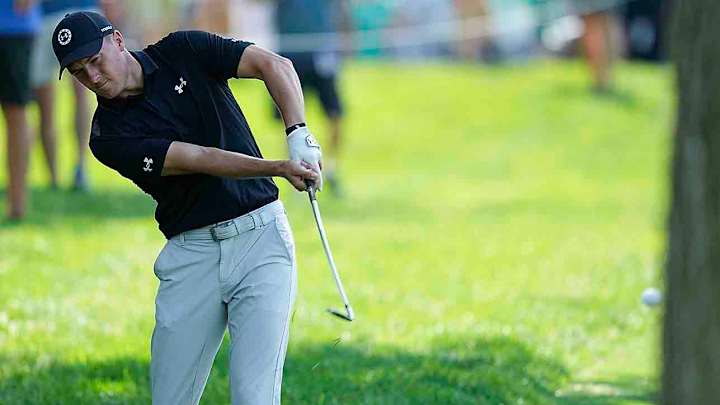With Artistry and Smarts, Jordan Spieth Fires a Solid Opening 69 at Muirfield Village

DUBLIN, Ohio — Nobody does golf quite like Jordan Spieth. Nobody does post-round interviews like him, either.
He tells it like it is, or at least the way he sees it, which is almost the same thing. And if you pay attention, you may learn something. Maybe it’s something about how to play the game, maybe it’s something inside-baseball-like that gives you an idea just how intricately he approaches the game. No detail is too small.
Exhibit A is his first-round 69 Thursday here at the Memorial Tournament. He was en route to a 68 until Muirfield Village’s mean 18th hole got in his way. Spieth salvaged a bogey with a superb greenside bunker shot and settled for 69, 3 under par. Still a very good score on a very difficult track. But there was a lot more to his round than just four birdies and a closing bogey. Some things you should know:
His bunker play is back. Wait, it was ever gone? Yes, he said, due to the wrist injury that has bothered him for the last month. “I feel like my touch is back,” he said. “I feel like bunker play is one of the strengths of my game and the last couple tournament’s it’s been really poor, actually poor enough to not allow me to have a chance to win golf tournaments.”

Spieth got up and down successfully four out of five times from bunkers Thursday. He hit only eight greens in regulation but scrambled brilliantly—you could say “Spiethily’ if you want to invent a new word. He was 9-for-10 in scrambling. That might be better than Waffle House’s average.
Spieth found the greenside bunker on the 1st hole, but played a 16-yard bunker shot to 5 feet and made par. “I hit a pretty fantastic shot there and it just gave me a lot of confidence,” he said. Here’s where he took it deep: “Like, all right, my entry point is back. I feel good about sliding the club under the ball and stuff like that.”
Entry point? Sliding the club under the ball? Name two things most of us average hackers don’t think about. On account of, you know, not really understanding them. If you’re like me, you worry more about the exit ramp and sliding the tip back into your pocket before the server notices it.
Spieth blames his problems on the PGA Championship at Oak Hill. “I got thrown off at the PGA, I had a lot of really weird, difficult bunker shots there,” he said. “I had a lot of plugged likes, some 30-yard ones from upslopes. And then at Colonial, I sent one too far once and then I just bailed on a bunch. I just needed to work on it. It’s the one part of the game I’ve worked on the least since I injured my wrist because it’s the one thing that hurts the most, flicking a bunker shot over like that.”
That makes total sense. So does checking out the golf course in advance when you’ve got an afternoon tee time, as Spieth did Thursday. Whether it’s watching some early TV action, if that’s an option, or studying online, if you’re a player looking for an edge that might save you one stroke, which is huge on the PGA Tour, why wouldn’t you?
“This is one of those tournaments you look at the app and see where everyone's hitting shots and what they're making and where they're leaving it to certain pins,” Spieth said. “You pay more attention to it because you just have to think your way through this when it gets like this.”
Muirfield Village is extra firm and fast for a change, after a recent dry spell and sudden warm surge as temperatures head towards 90 on Friday. Plus, the rough is up. It looks suspiciously like U.S. Open-quality rough. Hence, why only one player got to 5 under par Thursday—Davis Riley—and only one other got to 4 under, Matt Wallace.
Checking out the app—presumably Spieth meant ShotLink—is one advantage of a late tee time. Which makes up for playing in the afternoon, when the greens are usually roughed up by the morning wave of golfers. At major championships, which typically feature all-day coverage, players may actually get a read on a putt they’re going to have by watching golf before they go out. Studying the app, as Spieth did—that’s just smart. That’s being a veteran. That’s Spieth being Spieth (with apologies to former baseball player Manny Ramirez, who started the whole “That’s just Manny being Manny” cliché).
Now, about the firm conditions. The greens were so firm, appropriately so, Spieth said, that they were “probably the best surfaces I’ve ever putted on a Thursday afternoon. You didn’t have to fix hardly anything. I was shocked at how fantastic they were.”
Walking it in for birdie 💪@JordanSpieth heads to the last with a share of the lead @MemorialGolf. pic.twitter.com/UVpV5QHC64
— PGA TOUR (@PGATOUR) June 1, 2023
It’s inside-baseball stuff again, except it’s golf. The greens are so firm, they’re in better condition for the afternoon wave and thus make later tee times less of a disadvantage. Firm conditions make the course more challenging tee-to-green, however, because tee shots roll out more and find the rough more often. A handful of players didn’t break 80, for instance, including defending champ Billy Horschel, who posted 84.
“All the fairways are half the width they normally are, that’s what makes it such a challenge,” Spieth said. “If you miss them, you almost can’t hold them. You’ve got to try to play the par-5s under par and hold on over the rest.”
Thursday, Spieth beat a tough golf course, a good sign with the U.S. Open looming in two weeks. “It felt like a great round,” he said, because he didn’t strike the ball particularly well and it was actually “kind of an off day in that.” But he got away with a lot.
Scrambling like an artist and turning an off day into a good score on a tough course is classic Spieth. Others before him had the game in a similar fashion. The young Arnold Palmer. Ben Crenshaw. Phil Mickelson. Tiger Woods. Not Jack Nicklaus. Definitely not Ben Hogan.
Similar, yes. But nobody does it quite like Spieth.
